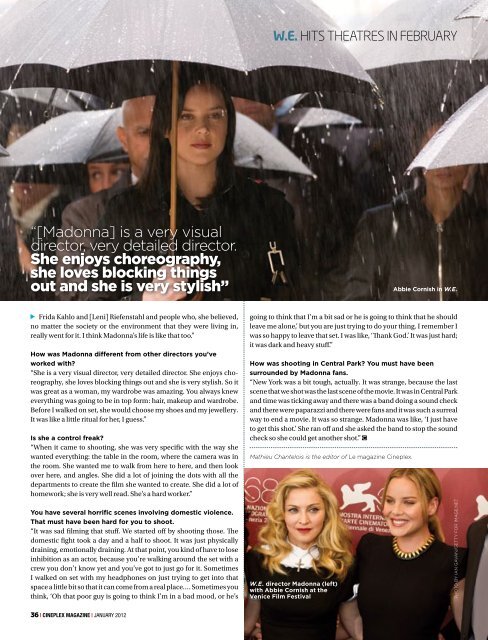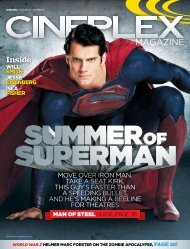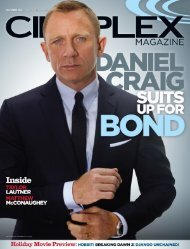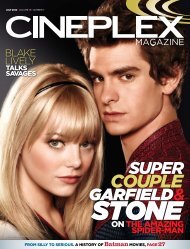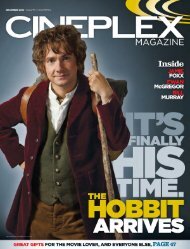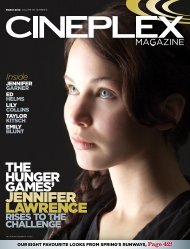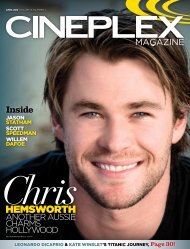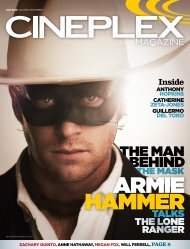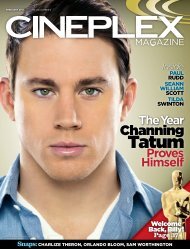You also want an ePaper? Increase the reach of your titles
YUMPU automatically turns print PDFs into web optimized ePapers that Google loves.
“[Madonna] is a very visual<br />
director, very detailed director.<br />
She enjoys choreography,<br />
she loves blocking things<br />
out and she is very stylish”<br />
Frida Kahlo and [Leni] Riefenstahl and people who, she believed,<br />
no matter the society or the environment that they were living in,<br />
really went for it. I think Madonna’s life is like that too.”<br />
How was Madonna different from other directors you’ve<br />
worked with?<br />
“She is a very visual director, very detailed director. She enjoys choreography,<br />
she loves blocking things out and she is very stylish. So it<br />
was great as a woman, my wardrobe was amazing. You always knew<br />
everything was going to be in top form: hair, makeup and wardrobe.<br />
Before I walked on set, she would choose my shoes and my jewellery.<br />
It was like a little ritual for her, I guess.”<br />
Is she a control freak?<br />
“When it came to shooting, she was very specific with the way she<br />
wanted everything: the table in the room, where the camera was in<br />
the room. She wanted me to walk from here to here, and then look<br />
over here, and angles. She did a lot of joining the dots with all the<br />
departments to create the film she wanted to create. She did a lot of<br />
homework; she is very well read. She’s a hard worker.”<br />
You have several horrific scenes involving domestic violence.<br />
That must have been hard for you to shoot.<br />
“It was sad filming that stuff. We started off by shooting those. The<br />
domestic fight took a day and a half to shoot. It was just physically<br />
draining, emotionally draining. At that point, you kind of have to lose<br />
inhibition as an actor, because you’re walking around the set with a<br />
crew you don’t know yet and you’ve got to just go for it. Sometimes<br />
I walked on set with my headphones on just trying to get into that<br />
space a little bit so that it can come from a real place…. Sometimes you<br />
think, ‘Oh that poor guy is going to think I’m in a bad mood, or he’s<br />
36 | <strong>Cineplex</strong> <strong>Magazine</strong> | january <strong>2012</strong><br />
W.E. hits theatres in FeBrUarY<br />
going to think that I’m a bit sad or he is going to think that he should<br />
leave me alone,’ but you are just trying to do your thing. I remember I<br />
was so happy to leave that set. I was like, ‘Thank God.’ It was just hard;<br />
it was dark and heavy stuff.”<br />
How was shooting in Central Park? You must have been<br />
surrounded by Madonna fans.<br />
“New York was a bit tough, actually. It was strange, because the last<br />
scene that we shot was the last scene of the movie. It was in Central Park<br />
and time was ticking away and there was a band doing a sound check<br />
and there were paparazzi and there were fans and it was such a surreal<br />
way to end a movie. It was so strange. Madonna was like, ‘I just have<br />
to get this shot.’ She ran off and she asked the band to stop the sound<br />
check so she could get another shot.”<br />
Mathieu Chantelois is the editor of le magazine <strong>Cineplex</strong>.<br />
W.E. director Madonna (left)<br />
with Abbie Cornish at the<br />
Venice Film Festival<br />
Abbie Cornish in W.E.<br />
Photo By ian gavan/getty for iMage.net


